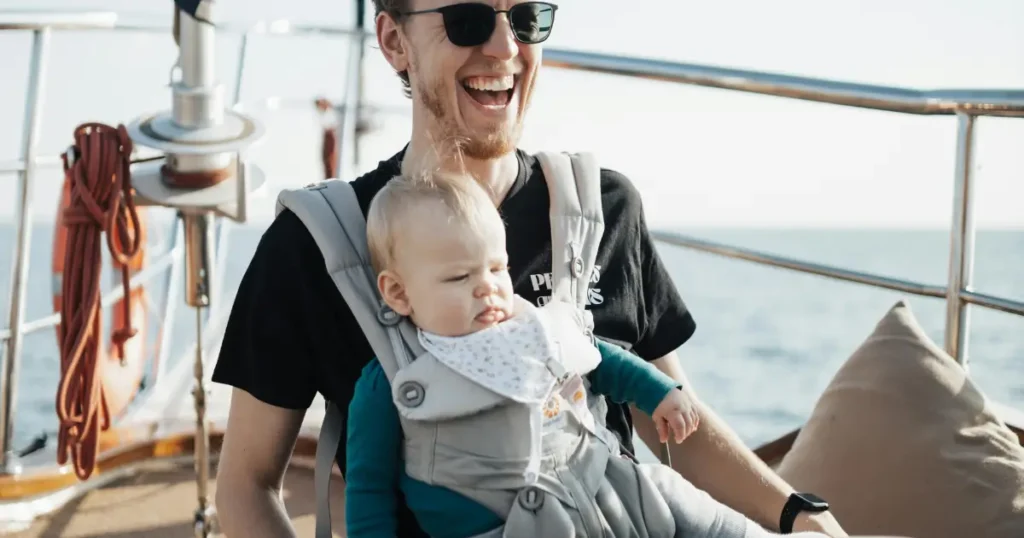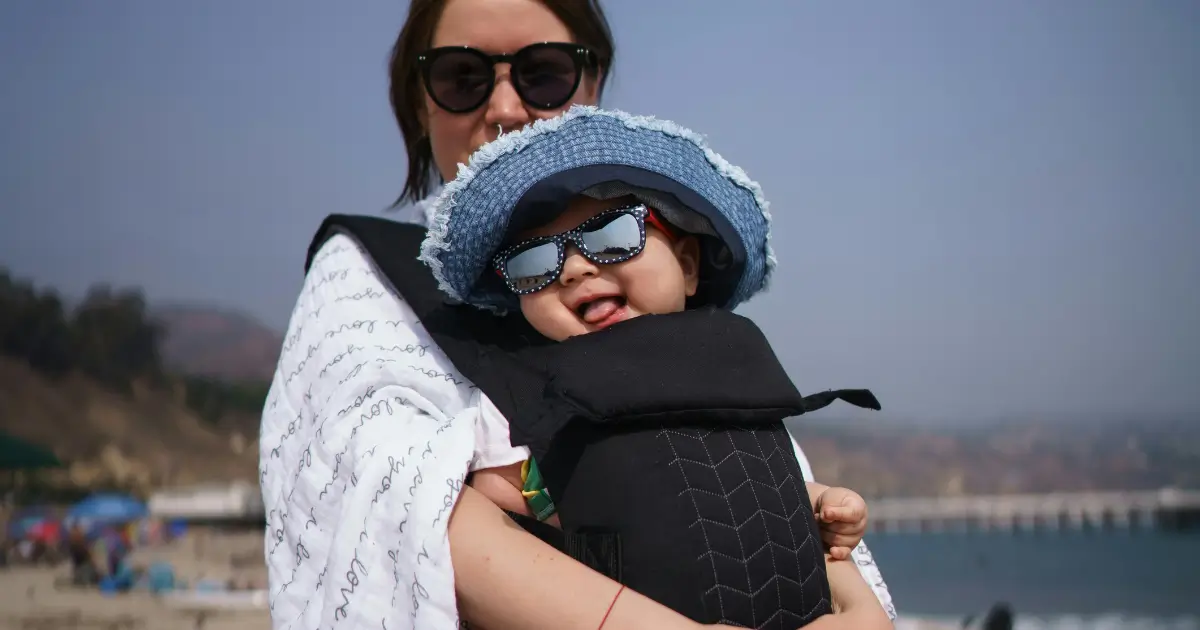Selecting the right baby carrier seat for your little one is one of the most important decisions you’ll make as a parent. A comfortable, secure, and reliable carrier not only helps you manage daily tasks but also ensures your baby’s safety during outings or trips. With so many options available on the market, finding the perfect one for your needs can feel overwhelming. But don’t worry—this guide will help you understand what to look for in a baby carrier seat and how to make an informed choice that guarantees comfort, safety, and convenience for both you and your baby.
Table of Contents
Why Choosing the Right Baby Carrier Seat Matters
A baby carrier seat isn’t just about convenience; it’s about providing a secure, supportive, and comfortable experience for your baby while allowing you to maintain your mobility. Whether you’re taking a stroll through the park or running errands, the right carrier can make all the difference. Improper carriers can cause discomfort for your baby, strain your body, and increase the risk of accidents. Choosing a baby carrier that balances comfort, support, and functionality is essential for both of you.
Factors to Consider When Choosing a Baby Carrier Seat
Comfort for Your Baby
The first factor to consider is comfort. Your baby will likely spend a significant amount of time in the carrier, so choosing one that provides adequate support is essential. Look for a carrier that evenly distributes your baby’s weight to avoid putting too much pressure on their hips, back, or shoulders. An ergonomic seat design is especially important as it promotes healthy posture and avoids long-term strain.
Padded straps and breathable fabric are key components in ensuring your baby’s comfort. Make sure the carrier is made from soft, non-irritating materials that are gentle on your baby’s delicate skin.
Safety Features You Can’t Ignore
When it comes to baby carriers, safety should always be your top priority. Look for a carrier with secure adjustable buckles, straps, and a sturdy frame to keep your baby safe while you’re on the go. Ensure that the carrier offers reinforced head support, especially for newborns, to prevent head lag and to ensure they’re secure.
Also, check the weight limits specified by the manufacturer to ensure the carrier is appropriate for your baby’s age and size. A poorly designed carrier can cause accidents, so it’s crucial to choose one that has passed rigorous safety standards.
Ease of Use for Parents
You’re going to be the one using the carrier most of the time, so it’s important to select one that’s easy for you to put on, adjust, and remove. Some baby carrier seats are designed to be put on without assistance, while others may require some extra help. Look for features like easy-to-adjust straps that make it simple to tailor the fit for both you and your baby.
A quick-release buckle or one-handed adjustment feature can make life much easier when you’re handling groceries, your baby, or simply need to get things done with one hand.
Size and Weight Limitations
While you might be tempted to purchase a baby carrier seat that can accommodate your baby for years, it’s important to consider the weight limitations and age recommendations. Some carriers are better suited for newborns and smaller babies, while others are designed to hold larger toddlers.
Make sure you choose a carrier that aligns with your baby’s current weight and size, and don’t forget to check if the carrier is adjustable as your baby grows.
Types of Baby Carrier Seats
Soft Structured Carrier
A soft-structured carrier (SSC) is one of the most popular types of baby carriers. These carriers feature padded shoulder straps and a waist belt for maximum comfort and support. They also typically offer multiple carrying positions (front, back, hip), which makes them versatile.
SSC carriers are known for their ease of use and ergonomic design, making them ideal for parents who need a reliable carrier for extended periods. Brands like Ergobaby and BabyBjörn are leaders in this category.
Wrap Carrier
A wrap carrier is essentially a long piece of fabric that you tie around your body to create a snug, secure seat for your baby. Wrap carriers are perfect for newborns and younger babies who require more closeness and comfort. They provide excellent weight distribution, especially in the early stages when your baby is small.
However, wrap carriers require a bit more skill to tie and adjust correctly. They are lightweight and compact, making them a great option for travel or quick trips to the store.
Sling Carrier
The sling carrier is a simple, one-shoulder design that allows you to carry your baby on your hip. Sling carriers are convenient for quick, short trips, but they may not provide the same level of support as other carriers, particularly for longer durations. However, they’re a popular choice for parents who want quick and easy access to their baby.
Backpack Carrier
A backpack carrier is designed for active parents who enjoy hiking or outdoor adventures. These carriers feature a sturdy frame and a seat for your baby, allowing you to carry them comfortably on your back. Many backpack carriers are equipped with additional storage compartments, making them perfect for long trips.
Top Features to Look for in a Baby Carrier Seat

Adjustable Straps
Adjustable straps are essential for ensuring both your baby’s comfort and your own. Look for a baby carrier seat that has easily adjustable shoulder straps, a waist belt, and a chest strap. This will allow you to customize the fit to your body, providing better weight distribution and reducing strain on your shoulders and back.
Breathable Materials
You’ll want to choose a carrier made from breathable materials like cotton or mesh to ensure proper ventilation. Babies can get hot quickly, and a carrier that traps heat can cause discomfort and sweating. Look for carriers designed with moisture-wicking fabrics that keep both you and your baby cool and dry.
Ergonomic Design
An ergonomic design helps ensure that your baby’s body is positioned correctly and safely. It’s crucial that your baby’s hips, spine, and legs are supported in a natural position to prevent issues like hip dysplasia. Opt for a carrier with an ergonomically shaped seat that promotes healthy development.
How to Properly Use and Adjust a Baby Carrier Seat
Proper usage and adjustments are key to ensuring the safety and comfort of both you and your baby. Here’s a quick guide:
- Adjust the straps to fit your body properly before placing your baby in the carrier. Ensure the shoulder straps are snug but not too tight, and the waist belt should sit comfortably on your hips.
- Position your baby correctly in the carrier. For newborns, make sure they are in an upright position with their legs in a “M” shape to support their hips. For older babies, ensure they are seated with their back supported.
- Check for tightness. The carrier should be snug enough to keep your baby secure but not overly tight, restricting movement or airflow.
- Make regular adjustments as your baby grows. Constantly check the straps and the fit to ensure everything stays secure.
Frequently Asked Questions (FAQ)
What is the best baby carrier seat for newborns?
For newborns, a soft structured carrier with adjustable settings or a wrap carrier that supports the baby’s head and neck is ideal. Look for one that offers newborn inserts for extra support.
Can I use a baby carrier seat for long walks?
Yes, as long as the carrier is designed for extended wear and has adjustable straps, padded shoulder straps, and a supportive waist belt. Soft structured carriers and backpack carriers are particularly good for long walks or hikes.
Are sling carriers safe?
Sling carriers can be safe if used properly, but they are best for short durations and babies who have good neck control. Always ensure the baby’s airway is clear, and they are not in a slouched position.
How do I clean my baby carrier seat?
Most baby carriers come with cleaning instructions. Many are machine washable, while others require hand washing. It’s important to follow the manufacturer’s guidelines to ensure the carrier maintains its durability.
Choosing the right baby carrier seat involves more than just picking a trendy design. It’s about finding the perfect balance of comfort, safety, and usability for both you and your baby. From ergonomic support to breathable materials, each feature plays a role in ensuring the best possible experience for both parent and child. Consider the type of carrier that best suits your lifestyle, whether you’re an outdoor enthusiast or someone who just needs a practical option for everyday outings.
By keeping these factors in mind, you
can confidently select a baby carrier seat that meets all your needs, ensuring your baby stays comfortable and secure, while you enjoy the freedom to move through your day with ease.
This comprehensive guide is designed to help you make an informed, confident decision. If you need further assistance in narrowing down your choices, don’t hesitate to revisit these points and find a carrier that truly works for you!
